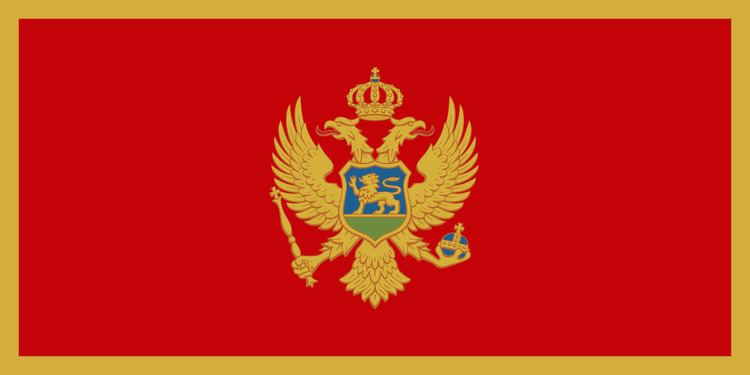Design Vertical format Proportion 1:2 | Adopted on 13 July 2004 Country Montenegro | |
 | ||
Design A red field surrounded by a golden border; charged with the Coat of Arms at the centre. The coat of arms in the flag occupies ⁄3 of its height. The width of the golden border is ⁄20 the width of the hoist side Design Blue with the national flag in as its canton, occupying ⁄5 of its width and ⁄2 of its length with a white anchor interlaced with three lines representing the surface of the water in the right side of the flag. Use National flag, Civil ensign, State ensign | ||
National flag of montenegro flying on the wind
The flag of Montenegro (Montenegrin: Застава Црне Горе / Zastava Crne Gore) was officially adopted with the Law on the state symbols and the statehood day of Montenegro on 13 July 2004 at the proposal of the government of Montenegro. It was constitutionally sanctioned with the proclamation of the Constitution on 22 October 2007. It is a red banner with broader golden edges all around the red field with the coat of arms of Montenegro in its center.
Contents
The Law on the state symbols and the statehood day of Montenegro reached full effect the day after its publication in the Official Gazette of Montenegro. The publication occurred 12 July 2004 and the legal power of the Law occurred the day after, on 13 July 2004 - the statehood day of Montenegro.
Description
The flag of Montenegro is red, with the coat of arms in the middle, and golden borders. The ratio of the flag is 1:2. The coat of arms takes up 2⁄3 of the flag's height. The middle point of the coat of arms matches the middle point of the flag. The width of the border is 1⁄20 of the flag's proportions. Two versions of the Montenegrin flag are in use, horizontal, mostly used outdoor; and vertical, mostly used indoor.
Use of flag
The flag is permanently hoisted on:
The flag is also hoisted on:
The flag may also be hoisted during international meetings, political, scientific, cultural, artistic, sporting and other manifestations in which Montenegro is represented, according to the rules of such events.
According to international tradition, when the flag is hoisted together with one or more flags of other states or international organizations on Montenegrin soil, the flag takes the place of honour. The place of honour is considered the center of a circle, the top of a semicircle, the first place in a row, column or a group of flags, the central position between the flags and the left side as seen from the front from the flags of other states or international organizations.
The flag is hoisted, lowered and carried with the usual honors (standing up, saluting etc.) The flag can not be hoisted so as to touch the ground, nor should be used as a table cloth, curtain or similar.
Historical
The historical war flags were the krstaš-barjak, plain flags with crosses in the center.
Flags as the state symbols were introduced only in the time of Petar II Petrović-Njegoš. Before him, the principal Montenegrin flag had been the alaj-barjak (regimental colors) with a single symbol on it - the cross (krst). The first written description of a Montenegrin flag dates from the time of Šćepan Mali: it was white, with a red frame and a golden cross on top of the spear. The next comes from 1838: pale-yellow with the small red cross, and in 1876 the flag was described as red with a white cross. At the time of Prince Danilo, the cross on the alaj-barjak was replaced by the two-headed eagle with the initials DI (Danilo I) on its breast, with the lion passant underneath. Prince/King Nikola used many different flags in his time. The first of the variants was the same as Danilo's, differing only in the initials - NI (Nikola I). Around 1910, two new variants appeared: one tricolor (red, blue and white) with the two-headed eagle bearing the initials NI on its breast and the lion passant on the sinister, the other with the two-headed eagle above the initials NI.
In late 1946 a new flag of the People's Republic of Montenegro, a constituent republic of the Federal People's Republic of Yugoslavia was adopted. It returned the traditional tricolor adding an ideological communist Red Star to its center. This flag was used until 1992, when the proclaimed flag was red, bluish and white vertical tricolor, with the size ratio of 1:3.
